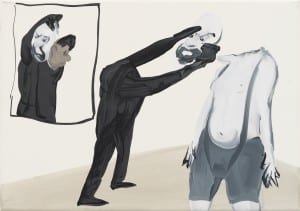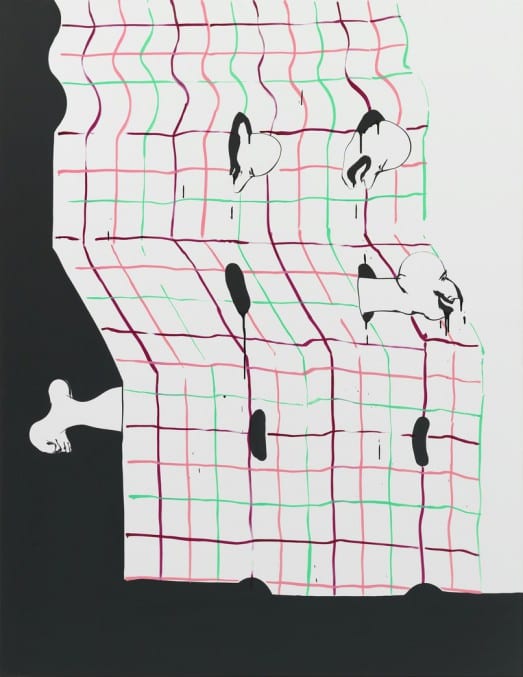Tala Madani: An Introduction
Posted on by Fay Curtis.
Julia Carver, Curator – Visual Arts
Manual Grid by Tala Madani is on display in the Modern Art in Britain: Reality Questioned exhibition. We decided to show it because it’s a 21st century meditation on Abstract art of the 20th century.
Tala Madani was born in Tehran in 1981 and moved to America when she was thirteen, settling in Portland, Oregon. She studied Political Science before deciding to study art under a scholarship in Oregon. She completed her art training at Yale.
Madani has said that she was attracted to art because of her difficulties learning English when she first moved to the US. Verbal versus visual language is a recurring struggle in her work.
At Yale she studied with the Abstract artist Peter Halley. She became immersed in American postwar abstract art, but also the Conceptualism that rejected the individualistic gestures of Action painting. In Halley she found a theorist who was able to make Abstraction meaningful in a contemporary context, relating American postwar art’s shift to Abstraction to a crisis at the horror of the Second World War.
Halley also talks about our technological era as an abstract one, where devices from cars to telephones have detached us from real contact: this is perhaps even more relevant in the digital age. In the 90s Halley called Abstract art the ‘reality of the abstract world’. He also notes how Andy Warhol, whenever asked about anything serious in life would say ‘it’s so abstract’.
In an art world predominated by installation, photography, performance and video Madani is perhaps unusual in choosing painting for her medium. She never makes prep studies but draws with her brush directly onto the canvas. She has also made stop-start animations with her paintings.

Double Head Index by Tala Madani
Her work is populated only by men. They seem to be caricatures but perhaps they are reflections of our own anxieties in the post-911 world. There is often something violent taking place or being hinted at.
Madani came to prominence with her Dazzlemen paintings which are based on the British military’s use of a kind of Cubist camouflage to conceal or confuse the identity of warships. Madani speaks about her interest in the use of camouflage by an aggressor, as a form of entrapment.
In the Dazzlemen paintings the men appear to be at some kind of seminar on becoming the Dazzlers: they take on the stripes but in a puzzled manner. There is something infantile about Madani’s men.
Madani has discussed how the pure colour sensations of American Abstract painting can sometimes seem to her a desire not to verbalise, even to hide behind rather than discuss difficult subjects. Her own painting addresses this: we wonder who the men are, they appear to be Middle Eastern, are we being racist in observing them as subjects of ridicule?
Why are there no women? Is this about excluding women from public life? Conversely it has been suggested that the humiliations Madani subjects her male figures to could be a reference to the War on Terror and the US treatment of inmates at Abu Ghraib.
Madani is never explicit about this and veers away from the suggestion that the men are Middle Eastern. She has said that she chooses not to represent women because of a difficulty getting away from the sexualisation of women.

Manual Grid by Tala Madani
Manual Grid displays these concerns: Madani’s engagement with Modernism – the visual pun on the discs that become illusionistic holes through which the men peer through, as if through stocks; the unsettling portrayal of men who look like this in this situation.
It’s part of the 2012 Manual Man series – which has been described as a ‘manual for masculinity’. Men are shown in positions of envy and desire, there is a sense of peer pressure, of wanting to be the other man, even a certain homo eroticism.
Finally we need to consider Madani’s assessment of formalism in art in relation to her native Iranian culture and the dominant Islamic traditions that resist the figurative image. Could there be an analogy here between the taboo regard for the image in traditional Islam and the distancing of Abstraction in the West?
Interestingly, while Madani has not shown her paintings in Iran, her animations circulate freely. Perhaps in finding her visual language Madani is managing her own sense of being in between two cultures.
Main image: Manual Grid © Tala Madani